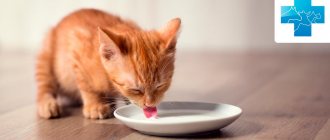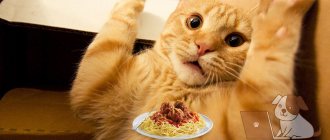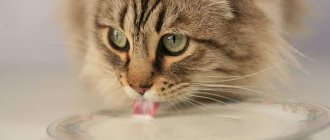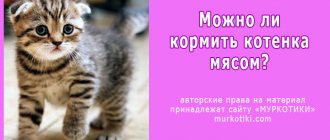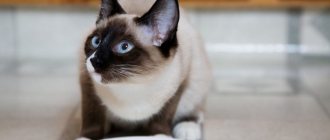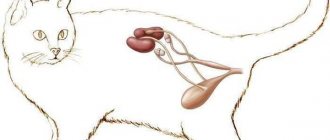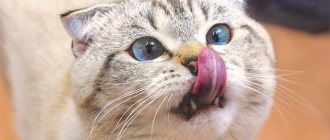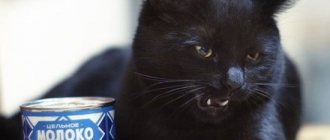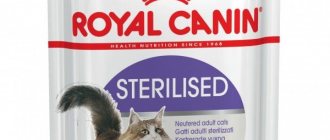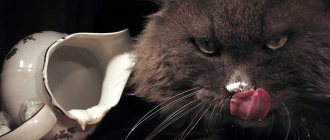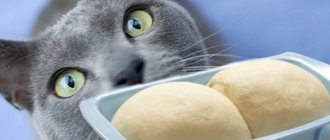Sterilization today is a simple operation, well-worked by veterinarians, which brings enormous benefits. First of all, this intervention is necessary for cat owners who do not want to deal with the sexual problems of their pet and the subsequent placement of her offspring. After sterilization, many things change in a cat’s life, and this necessarily entails changes in diet.
Psychology of a sterilized cat
Sterilization for a cat is a strong hormonal and psychological stress. That is why after it is carried out, some pets change beyond recognition. After physiological changes have occurred, a cat’s taste preferences may even change greatly.
Most often, sterilized animals have a significantly increased appetite, they sleep more, play less and have almost no interest in the street. This is explained by the low level of estrogen, which was produced by the ovaries before the operation. And also the absence of stress caused by sexual hunting. If the cat previously had free access to the street and actively hunted, then after the operation it may become completely uninteresting to her, and she will prefer to spend most of her time on her favorite sofa or chair.
Industrial feeding
A sterilized cat can be fed dry food if its quality is not in doubt. For daily feeding of healthy animals, premium food and higher are suitable. If you decide to alternate dry and wet food, purchase products from the same brand and series.
Important! Regardless of whether your cat is sterilized or not, whether she eats natural food or dry food, a drinking bowl with fresh and clean water should always be available to the pet.
There are many opinions about feeding sterilized cats with special food. If you carefully read the instructions on the packaging of such food, you will be able to draw the right conclusion. The fact is that special, medicinal foods are designed to regulate the acidity of urine, and this measure is valid if the cat has already developed urolithiasis. By using this food for “prevention”, you will disrupt the natural acidity of urine, which can lead to the formation of sand and stones.
Care after sterilization
Immediately after the operation, the cat is under the influence of anesthesia in an unconscious state. After 3-4 hours she begins to wake up. At this moment, the coordination of its movements is greatly impaired, so the animal must be placed on the floor in a dark, warm, draft-free place. It may take up to a day for your cat to fully recover.
A cat recovering from anesthesia initially does not eat or drink anything. How long it takes for her appetite to return depends on her general condition. If the animal is completely healthy and the operation went without complications, the desire to eat may appear within 3-4 hours after waking up. At this moment it is not yet advisable to feed her. The first time food should be given no earlier than a day later.
During the postoperative period, the cat should be provided with complete rest; a kitten or other animals should not even be allowed near it. It is better to ask your veterinarian in advance about how to prepare your pet for surgery and whether it is possible to feed it before sterilization. Proper preparation will greatly facilitate the rehabilitation process.
Find out more about how to care for your cat after sterilization.
Features of animal nutrition after surgery
The cat begins to experience a constant feeling of hunger and the owners simply need to reconsider their diet.
Moreover, this must be done well in advance, before the operation, so as not to make sudden changes during feeding. IMPORTANT! Veterinarians generally do not recommend changing dietary directions. If before the operation the cat was fed natural products, adjust the diet based on them. If industrial formulations were used, it is necessary to select food for sterilized cats from these lines. Sudden changes will bring discomfort and negatively affect the psycho-emotional state of the pet.
What else needs to be considered when feeding cats?
- Periodicity. As already noted, there should be no sudden changes in diet. If previously the cat received food twice a day, this regime must be maintained after surgery. However, the general recommendation is to feed often, but little by little. This will allow the pet not to feel hungry, and the digestive tract will be loaded steadily and evenly, which will allow the metabolism to be adjusted to a comfortable level.
- Providing water. In addition to specialized food for sterilized pets, it is important to take care of a sufficient amount of water. The cat should always have free access to it. This is especially important if the diet contains a large amount of dry food.
- Cats are hereditary carnivores, which means their stomach is adapted to digest meat even after surgery to remove the reproductive organs. You should not focus only on cereals and fiber. About 80% of the diet should be given to protein , preferably of animal origin.
What not to feed sterilized cats
The diet of a sterilized cat should be tailored to its physiological changes. There are a number of products that should be completely excluded from it:
- Fresh fish. It is a source of phosphorus, which in certain cases provokes the development of urolithiasis.
- Semolina. It is a source of large amounts of carbohydrates, as a result of which sterilized animals quickly gain fat.
- Fatty meats. Pork is especially harmful to cats.
- Potatoes and legumes. They contain virtually no substances beneficial to cats. But they can very easily provoke the development of diarrhea or diarrhea.
Veterinarians also advise not to feed them with regular ready-made food. For them, you should choose special ones designed for sterilized animals.
Can castrated cats have milk?
Not all animals are castrated - only domestic cats that do not walk outside are castrated. When getting a pet, not every owner is able to provide it with a stable, mature life. To get rid of unpleasant natural odors (the cat uses them to mark the territory of the apartment), you have to cut off its “claws”.
The procedure is performed on an adult pet whose diet contains more than just milk. Having sent the animal for surgery, you should immediately take care of a new menu, taking into account the characteristics of the body. And be sure to check with your veterinarian whether milk can be given to castrated cats.
Removing the testicles negatively affects the animal’s genitourinary system. Therefore, products are selected in such a way that they do not provoke the development of stones. Cow's milk, which is not suitable in composition for the cat's body, can pollute it.
The second problem that owners face is their pet’s excessive appetite. After castration, the internal energy of cats is redirected from the reproductive system to the digestive system. Full-fat milk is high in calories and can therefore lead to obesity.
Animals that quickly gain weight become sedentary and phlegmatic. This situation also negatively affects the urinary system - it is more difficult for the kidneys to serve the body clogged with cholesterol.
What to feed a sterilized cat
Immediately after surgery, the animal experiences psychological and physiological stress. Therefore, if a cat does not eat for 24 hours after sterilization, this is absolutely normal. Usually her appetite returns gradually. Everything is much worse when the cat does not drink for 7-8 hours after sterilization. She gradually begins to become increasingly dehydrated. If the animal still does not drink the next day, you should immediately contact the clinic. It is possible that the operation was not without complications, and therefore urgent medical intervention is required. For a weakened animal, the doctor will prescribe IVs and subcutaneous infusions that will combat dehydration.
When can you feed a cat after sterilization? Veterinarians recommend maintaining a fasting period for at least the first 12-16 hours after surgery.
In cases where the animal requires a large amount of food, it should still be limited in the first few days. This will help avoid unnecessary stress on the digestive organs.
The cat's diet after sterilization during the first week should consist of foods that will not cause problems with bowel movements. After them, she should easily go to the toilet. Unnecessary stress on the stitches due to constipation or diarrhea can significantly increase the healing process. So, for example, you could use the following:
- Natural yogurt, low-fat yogurt or 10% cream.
- Beef broth without fat and salt.
- Raw or boiled egg.
- Special canned food for animals after surgery.
In the first 3-4 days, meat and cereals should be completely excluded from the cat’s diet. If necessary, they can be replaced with baby meat puree with the addition of vegetables. Water should be given to the cat in unlimited quantities during this period. If your pet doesn’t drink much, you don’t need to force it to drink; perhaps it gets most of its liquid from liquid food.
About milk
Milk in our usual understanding is a product produced by the mammary glands of a cow or goat. Nature has made sure that female mammals always have food for their young. The natural function of milk is to feed offspring, cubs, whose digestive system is not yet capable of digesting other food.
If you analyze the chemical composition of milk, you can find many minerals in it: it contains calcium, magnesium, potassium, sulfur, chlorine, salts of phosphoric and citric acids, as well as chlorides. The most important substance found in large quantities in milk is calcium. It is present in the drink in different forms:
- 11% – in the form of free calcium;
- 66% – citric acid salts and phosphates;
- 23% – in the form of compounds with casein.
Dairy products contain balanced macronutrients. Without phosphorus, the body cannot absorb calcium and potassium, and sodium is absorbed only together with other minerals.
Milk contains microelements necessary for a living organism - iron, iodine, copper, zinc, manganese and others. They ensure the production of enzymes, hormones, and promote metabolic processes. Without them, the synthesis of vital amino acids and vitamins is impossible, and the development of negative processes is possible. For example, with a lack of selenium in the body, kittens lag behind in development, and in adult animals, degenerative processes in the genitourinary organs and pancreas are possible.
Iodine is no less important for your pet’s body. Its deficiency causes dysfunction of the pancreas, and a lack of zinc affects the digestion process.
In addition to macro- and microelements, milk contains:
- lactose is a natural carbohydrate;
- amino acids that are vital for cats;
- animal protein that cannot be synthesized or replaced with plant nutrients;
- fatty acids that contain vitamins A and D, cholesterol, which is involved in the synthesis of vitamin D and many hormonal processes in the animal’s body.
Side effects and contraindications
Cats are often allergic to cow's milk protein; in this case, the cat is strictly prohibited from any dairy or fermented milk products.
Casein, a milk protein, causes allergies in many cats. Goat milk is less allergenic - if you really want to pamper your pet, you can use it or special veterinary products - milk substitutes, which have a reduced content or are completely absent of milk sugar.
Milk is a high-calorie product, 80-140 calories in one bowl, and experts consider it acceptable to give pets no more than 30 calories per day from the category of unbalanced nutrition if you feed the cat natural food. Giving milk to your cat frequently can lead to overweight.
How to properly include milk in a cat's menu
The most common problem is the adult cat's inability to digest lactose, which causes diarrhea. Otherwise, there is no particular benefit or too much harm from cow's milk for domestic animals. Therefore, whether or not to give milk to a cat depends on the owner. The only limitation is that in order not to get a laxative effect, it is worth limiting the amount of milk for your pet - 10-15 ml per 1 kg of body weight.
By the way! In the wild, representatives of the cat family do not drink the milk of other animals.
For pets, fermented milk products with a fat content of no more than 9% are much more valuable and healthier. In the cat's menu you can include:
- kefir;
- occasionally - low-fat sour cream and low-fat cottage cheese;
- natural yogurt without sugar and fruit additives;
- a little bit of cheese.
Important!
It is strictly forbidden to give cats dairy cereal porridges: they contain easily digestible carbohydrates that can cause disruption of the intestinal microflora and a decrease in resistance.
Features of use
It's rare that a cat won't refuse a bowl of fresh milk, but veterinarians believe that giving an adult cat milk is not necessary. And in some cases it can cause harm to the pet's health. With cow's milk, pesticides from the grass that the cow was fed can enter the cat's body.
The milk that is sold in the store goes through a pasteurization process at the dairy, during which pathogens are destroyed. But during processing, some vitamins in milk are destroyed, proteins and other enzymes change, and the calcium contained in pasteurized milk is less absorbed.
Milk is 87.5% water. It does not cause any harm to a living organism, but besides it, it contains:
- lactose (milk sugar). A cat’s body is designed in such a way that it can digest lactose only in the first 2-3 months after birth, then milk sugar practically ceases to be absorbed, so milk can cause intestinal upset;
- fats. This is a small amount, but cats with a tendency to gain excess weight are recommended to limit their milk consumption;
- casein. After three months of age, kittens stop absorbing it because the body stops producing the enzyme lactase. Casein does not coagulate and is excreted from the body along with other unnecessary substances;
- globumin and albumin. These are proteins that have a positive effect on the immune system.
Milk for a kitten: benefit or harm
From birth, kittens drink their mother's milk. Outwardly, it does not differ from cow's, only the composition and proportions of nutrients and other nutrients are different. First of all, the difference concerns the fat and protein content. Cat milk is much richer than cow, goat and mare milk.
These indicators may vary depending on the diet of the nursing cat and the individual characteristics of the body, but even averaged data show that neither cow nor goat milk can replace the nutritional value of mother cat milk. That is why it is recommended not to separate a kitten from its mother early, and if natural feeding is not possible, it is better to use not whole cow’s milk, since it is not nutritious enough, but a special veterinary milk formula for kittens.
When feeding kittens with cow's milk, there are some things to consider:
- it is too high in calories and heavy for the pet’s fragile digestive system;
- if the cow was given antibiotics, they will enter the kitten’s body with the milk, causing dysbacteriosis or more serious dysfunctions of the digestive system;
- product from a pregnant cow contains a lot of the female hormone estrogen, which is harmful to kittens.
